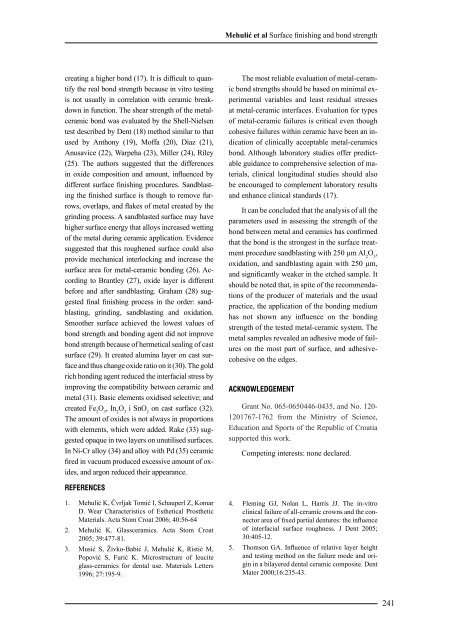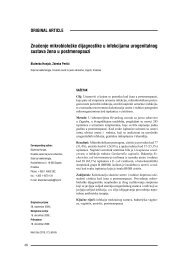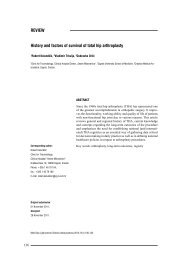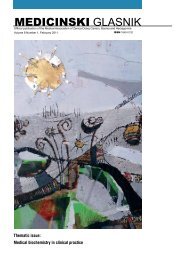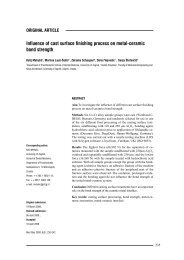MEDICINSKI GLASNIK
MEDICINSKI GLASNIK
MEDICINSKI GLASNIK
You also want an ePaper? Increase the reach of your titles
YUMPU automatically turns print PDFs into web optimized ePapers that Google loves.
creating a higher bond (17). It is difficult to quantify<br />
the real bond strength because in vitro testing<br />
is not usually in correlation with ceramic breakdown<br />
in function. The shear strength of the metalceramic<br />
bond was evaluated by the Shell-Nielsen<br />
test described by Dent (18) method similar to that<br />
used by Anthony (19), Moffa (20), Diaz (21),<br />
Anusavice (22), Warpeha (23), Miller (24), Riley<br />
(25). The authors suggested that the differences<br />
in oxide composition and amount, influenced by<br />
different surface finishing procedures. Sandblasting<br />
the finished surface is though to remove furrows,<br />
overlaps, and flakes of metal created by the<br />
grinding process. A sandblasted surface may have<br />
higher surface energy that alloys increased wetting<br />
of the metal during ceramic application. Evidence<br />
suggested that this roughened surface could also<br />
provide mechanical interlocking and increase the<br />
surface area for metal-ceramic bonding (26). According<br />
to Brantley (27), oxide layer is different<br />
before and after sandblasting. Graham (28) suggested<br />
final finishing process in the order: sandblasting,<br />
grinding, sandblasting and oxidation.<br />
Smoother surface achieved the lowest values of<br />
bond strength and bonding agent did not improve<br />
bond strength because of hermetical sealing of cast<br />
surface (29). It created alumina layer on cast surface<br />
and thus change oxide ratio on it (30). The gold<br />
rich bonding agent reduced the interfacial stress by<br />
improving the compatibility between ceramic and<br />
metal (31). Basic elements oxidised selective; and<br />
created Fe 2 O 3 , In 2 O 3 i SnO 2 on cast surface (32).<br />
The amount of oxides is not always in proportions<br />
with elements, which were added. Rake (33) suggested<br />
opaque in two layers on unutilised surfaces.<br />
In Ni-Cr alloy (34) and alloy with Pd (35) ceramic<br />
fired in vacuum produced excessive amount of oxides,<br />
and argon reduced their appearance.<br />
REFERENCES<br />
1.<br />
2.<br />
3.<br />
Mehulić K, Čvrljak Tomić I, Schauperl Z, Komar<br />
D. Wear Characteristics of Esthetical Prosthetic<br />
Materials. Acta Stom Croat 2006; 40:56-64<br />
Mehulić K. Glassceramics. Acta Stom Croat<br />
2005; 39:477-81.<br />
Musić S, Živko-Babić J, Mehulić K, Ristić M,<br />
Popović S, Furić K. Microstructure of leucite<br />
glass-ceramics for dental use. Materials Letters<br />
1996; 27:195-9.<br />
Mehulić et al Surface finishing and bond strength<br />
The most reliable evaluation of metal-ceramic<br />
bond strengths should be based on minimal experimental<br />
variables and least residual stresses<br />
at metal-ceramic interfaces. Evaluation for types<br />
of metal-ceramic failures is critical even though<br />
cohesive failures within ceramic have been an indication<br />
of clinically acceptable metal-ceramics<br />
bond. Although laboratory studies offer predictable<br />
guidance to comprehensive selection of materials,<br />
clinical longitudinal studies should also<br />
be encouraged to complement laboratory results<br />
and enhance clinical standards (17).<br />
It can be concluded that the analysis of all the<br />
parameters used in assessing the strength of the<br />
bond between metal and ceramics has confirmed<br />
that the bond is the strongest in the surface treatment<br />
procedure sandblasting with 250 µm Al 2 O 3 ,<br />
oxidation, and sandblasting again with 250 µm,<br />
and significantly weaker in the etched sample. It<br />
should be noted that, in spite of the recommendations<br />
of the producer of materials and the usual<br />
practice, the application of the bonding medium<br />
has not shown any influence on the bonding<br />
strength of the tested metal-ceramic system. The<br />
metal samples revealed an adhesive mode of failures<br />
on the most part of surface, and adhesivecohesive<br />
on the edges.<br />
ACKNOWLEDGEMENT<br />
Grant No. 065-0650446-0435, and No. 120-<br />
1201767-1762 from the Ministry of Science,<br />
Education and Sports of the Republic of Croatia<br />
supported this work.<br />
4.<br />
5.<br />
Competing interests: none declared.<br />
Fleming GJ, Nolan L, Harris JJ. The in-vitro<br />
clinical failure of all-ceramic crowns and the connector<br />
area of fixed partial dentures: the influence<br />
of interfacial surface roughness. J Dent 2005;<br />
30:405-12.<br />
Thomson GA. Influence of relative layer height<br />
and testing method on the failure mode and origin<br />
in a bilayered dental ceramic composite. Dent<br />
Mater 2000;16:235-43.<br />
241


